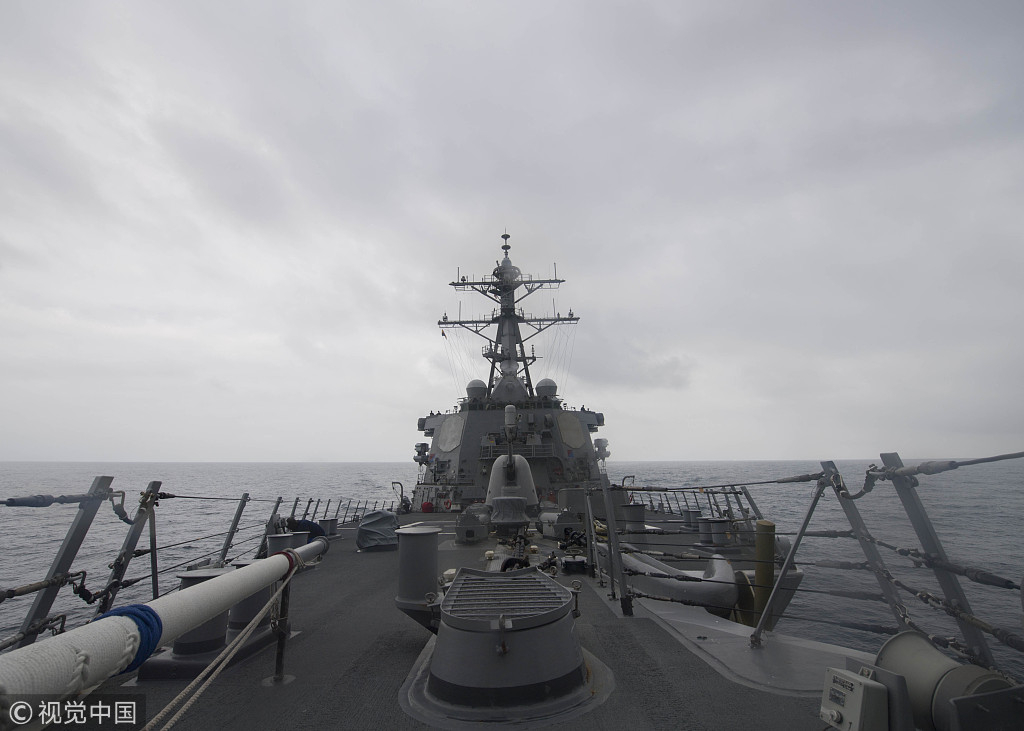
Opinion
21:33, 11-Feb-2019
Opinion: How China and U.S. can avoid conflict in the South China Sea
Peng Nian

Editor's note: Peng Nian is an assistant research fellow at National Institute for South China Sea Studies (NISCSS), a top think tank based in Haikou, China. The article reflects the author's opinion, and not necessarily the views of CGTN.
As the two major maritime powers, China and the U.S. have upgraded the military competition in the South China Sea in the past year, resulting in a tough security dilemma. On February 11, in an attempt to "challenge excessive maritime claims and preserve access to the waterways as governed by international law", two U.S. warships angered the Chinese government again with sailing in the South China Sea without permission.
America's South China Sea actions, which are guided by "freedom of navigation", have become more frequent in a worrying way. The U.S. navy has conducted as many as ten “freedom of navigation” operations (FONOP) since President Donald Trump took office,in order to deter China from expanding its military presence in the South China Sea and thus containing China's growing sea power in the Western Pacific region.
Such aggressive behavior triggered strong responses from the China side, in which the Chinese navy has taken counter-measures such as warning away the U.S. warships illegally entering Chinese waters and enhancing the military deployment in the region to guard its sovereignty and national interests.

The U.S. Arleigh Burke-class guided-missile destroyer USS John S. McCain (DDG 56)as it patrols the South China Sea on January 7, 2017. /VCG Photo
The U.S. Arleigh Burke-class guided-missile destroyer USS John S. McCain (DDG 56)as it patrols the South China Sea on January 7, 2017. /VCG Photo
The intense military confrontation, either offensive or defensive, between China and the U.S. in the South China Sea has raised concerns over the possible conflicts between the two countries in the near future. To be sure, the narrowing power gap between China and the U.S. at sea would not only increase the U.S. jitters about losing the hegemonic power in the Asia-Pacific and therefore introducing provocative policies and actions, but contribute China's power to maintain the stability in the region.
Moreover, the distrust between Beijing and Washington rooted in different political systems and ideologies would also intensify the situation in the South China Sea. Currently, the U.S. had already announced that China is a major strategic competitor as well as the far greater threat to U.S. than Russia.
But it seems that the judgment was made largely due to China's economic and military and its long frustrations with China's socialist system. It is viewed as a significant shift in America's China policy by Chinese scholars who believed that the U.S. would adopt a much more hawkish confrontation policy towards China, leading to more threats to peace the South China Sea region.
The latest incident and intense encounter between a U.S. Navy destroyer USS Decatur and a Chinese Navy warship in last year reveals the high risk of the frequent FONOPs in the South China Sea. From the American perspective, the FONOPs are the moderate actions with the lowest level of military deterrence. Therefore, it is more likely for the U.S. navy to take further steps to deter China, further threatening the stability in the region.

Vessels and aircraft including the aircraft carrier Liaoning and latest submarines, vessels and fighter jets take part in a review in the South China Sea on April 12, 2018. /Xinhua Photo
Vessels and aircraft including the aircraft carrier Liaoning and latest submarines, vessels and fighter jets take part in a review in the South China Sea on April 12, 2018. /Xinhua Photo
In order to help states get out of the security dilemma, experts have proposed various instruments aimed at promoting security cooperation between countries, such as signing bilateral and multilateral agreements and holding bilateral and multilateral forums. China and the U.S. have reached agreements on managing the maritime disputes at sea, such as the Code For Unplanned Encounters At Sea (CUES). However, these mechanisms are not effectively functioned due to lack of supervision. Furthermore, the rules and norms which could regulate the power competition between China and the U.S. in the South China Sea have not yet been constructed.
Given this, effective use of CUES and other risk management measures should become the top priority of China and the U.S. For instance, both sides could discuss how to avoid the unprofessional operations of the navies and establish a punishment mechanism. Besides, building hot lines between the commanders of the two navies is also a useful way to make emergency response plan and facilitate communication between the two naval forces. Finally, it is necessary for China and the U.S. to establish a peaceful coexistence mechanism so as to enhance mutual trust and prevent further escalation.
(If you want to contribute and have specific expertise, please contact us at opinions@cgtn.com)

SITEMAP
Copyright © 2018 CGTN. Beijing ICP prepared NO.16065310-3
Copyright © 2018 CGTN. Beijing ICP prepared NO.16065310-3